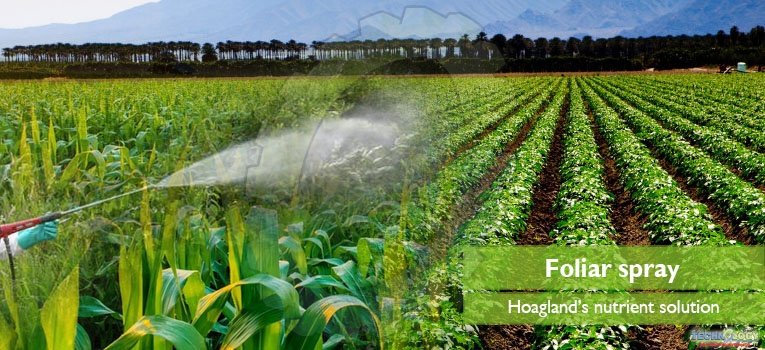Foliar spray of different micro and macro-nutrients has been beneficial for crop growth. The nutrients present in the soil may not be always sufficient to accomplish the crop need. Therefore, macro and micro-nutrients require for crop growth and development

Agriculture is the mainstay of Pakistan’s economy. It is responsible for providing basic human needs including food, feed, fiber and shelter for the people and accounts for 21.4% of GDP.
Foliar spray of different micro and macro nutrients has been beneficial for crop growth. The nutrients present in the soil may not be always sufficient to accomplish the crop need. Therefore, macro and micro-nutrients require for crop growth and development may not be provided to plants with soil applied fertilizers. Thus, the foliar application is the substitute method to apply these nutrients.
Nutrient losses in the soil can be decreases by foliar nutrition and it may be economical for growers. It is most suitable technique to reduce the nutrient deficiencies and increasing cost of production of crops. Among various constraints.
The increase in cropping intensity and less use of fertilizers are the main factors that are responsible for nutrients reduction occurring in soils. Scarcities of both nutrients (macro and micro) impart negative effect on various crops.
There are many approaches to nourish the crop plant whereas, foliar spray of nutrients is observed the most efficient technique in relation to nutrients uptake.
Nutrients applied through leaves play a key role in improving the grain yield of pulses. Major nutrients such as NPK applied through foliar application is more beneficial than soil application and also evading the reduction of nutrients in leaves. Thus increased the photosynthetic rate improve the nutrient translocation from the leaves to the emerging seeds.
Foliar spray: A foundation for better plant growth
However, losses of nutrients from leaching and fixation are reduce by exogenous application of nutrients that attributes with the benefit of rapid and effective consumption of nutrients, and assistance in nutrients uptake by crop plants.
In Pakistan, farmers mostly concerned only with the macro-nutrients for crop growth. But different studies on various crops shows that combination of micro and macro-nutrients plays a key role not only in crop production but also helpful to correct many physiological disorders.
However, it is a dire need to use such a nutrients mixture which contains both micro and macro-nutrients. In this way foliar application of Hoagland’s nutrients solution is the best that bears both micro and macro-nutrients (N, P, K, Ca, Mg, S, Fe, Cl, B, Mn, Zn, Cu and Mo).
Table 1 shows the original concentrations for each element for developing the Hoagland’s nutrients solution. Macronutrients are added separately from the stock solution to prevent precipitation. A combine stock solution is shown containing all micronutrients except iron.
Hoagland’s nutrients solution
Hoagland’s nutrients solution is a mixture of nutrients that offers each nutrient vital for the plant growth which is the most vibrant solutions for growing plants under specific conditions. For plant growth and development, this solution delivers every essential nutrient.
This solution is also important for the growth of an excessive variety of plant species. In the sequence of Hoagland’s nutrients solution studies Hoagland make and practice effectively in different experimental trials which are recognizing in the entire field as Hoagland’s culture solution.
However, if farmers apply the Hoagland’s nutrients solution to crops at different growth stages (7, 14 and 21 days after crop emergence) it will significantly enhance the benefit cost ratio by improving the crop growth and yield to greater extent.
Table 1: Composition of a modified Hoagland’s nutrients solution
|
Compound |
Element |
Stock Concentration (gL-1) |
Concentration (ppm) |
|
KNO3 |
N K |
101.10 |
224 235 |
|
NH4H2PO4 |
P |
115.08 |
62 |
|
Ca(NO3)2.4H2O |
Ca |
236.16 |
160 |
|
MgSO4.7H2O |
S Mg |
246.49 |
32 24 |
|
NaFeDTPA (10% Fe) |
Fe |
30.00 |
3 |
|
KCl |
Cl |
1.864 |
1.77 |
|
H3BO3 |
B |
0.773 |
0.27 |
|
MnSO4.H2O |
Mn |
0.169 |
0.11 |
|
ZnSO4.7H2O |
Zn |
0.288 |
0.13 |
|
CuSO4.5 H2O |
Cu |
0.062 |
0.03 |
|
MnMoO4 (85% MoO3) |
Mo |
0.040 |
0.05 |
(Epstein, 1972 and 1994)
This article is jointly written by Hasnain Waheed and Dr. Muhammad Mansoor Javaid. The authors are from Department of Agronomy, University of Sargodha, Sargodha. Corresponding author can be reached at hasnainwaheed90@yahoo.com